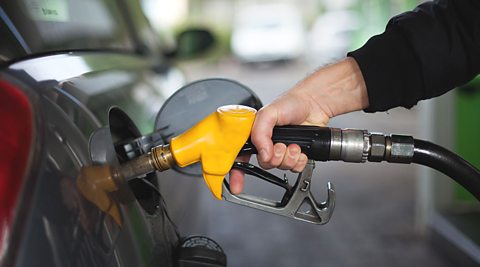Hydrogen versus petrol
For more than a century most cars have been fuelled by petrol or diesel. Hydrogen is another fuelMaterial that is used to produce heat, like coal, oil or gas. that can be used for cars. It has advantages over petrol but it has disadvantages too.
Production of hydrogen and petrol
Petrol
Petrol is a non-renewableA resource that cannot be replaced when it is used up, such as oil, natural gas or coal. fossil fuelNatural, finite fuel formed from the remains of living organisms, eg oil, coal and natural gas.. It is made from crude oilMixture of hydrocarbons, mainly alkanes, formed over millions of years from the remains of ancient dead marine organisms., a finite resourceA resource that is no longer being made or which is made extremely slowly, such as crude oil and metal ores.. Some of the substances found in petrol are made by crackingThe breaking down of large hydrocarbon molecules into smaller, more useful hydrocarbon molecules by vaporising them and passing them over a hot catalyst. crude oil fractions, a process which uses large amounts of energyThe capacity of a system to do work or the quantity required for mechanical work to take place. Measured in joules (J). For example, a man transfers 100 J of energy when moving a wheelbarrow..
Hydrogen
Hydrogen is manufactured in several ways. These include:
- reaction of methane from natural gas with steam
- cracking of crude oil fractions (hydrogen is a by-product of this process)
- electrolysisThe decomposition (breakdown) of a compound using an electric current. of water
Methane is a non-renewable fossil fuel made from natural gas, a finite resource. The production of hydrogen from natural gas or from crude oil offers no advantage over petrol.
Question
The electrolysis of water needs large amounts of electrical energy. Explain an advantage and a disadvantage of producing hydrogen by the electrolysis of water.
Hydrogen can be renewable if the electricity is generated from renewable resources, such as sunlight and wind. However, most electricity worldwide is generated from coal, oil or natural gas. Hydrogen produced this way will be non-renewable.
Combustion products
Petrol
incomplete combustionBurning when there is a limited supply of air or oxygen. happens in cars fuelled with petrol. This produces:
- carbon particles, which appear as smoke and sootThe fine black particles, chiefly composed of carbon, produced by incomplete combustion of coal, oil, wood, or other fuels.
- carbon monoxidePoisonous gas produced during incomplete combustion., a toxic gas
Question
Carbon dioxide is produced during the combustion of petrol. Describe a problem this causes to the environment.
Carbon dioxide is a greenhouse gas. Increasing amounts of this gas are linked to global warming and climate change.
Hydrogen
Hydrogen usually provides the fuel for hydrogen-oxygen fuel cellDevice that produces a voltage continuously when supplied with a fuel and oxygen. in cars. However, it can also be used in some internal combustion engines (the type of engines found in petrol cars). However, water is the only product of combustion when hydrogen is used.
There are far fewer hydrogen filling stations than petrol filling stations. Depending on where you live, this could make it more difficult to run a car fuelled by hydrogen.

Other features
The table shows some other features of hydrogen and petrol as fuel for cars.
| Hydrogen | Petrol | |
| Ease of ignition | Very flammable - ignites easily | Very flammable - ignites easily |
| Energy released per kg of fuel (MJ) | 142 | 46 |
| State at room temperature and pressure | Gas | Liquid |
| Ease of ignition | |
|---|---|
| Hydrogen | Very flammable - ignites easily |
| Petrol | Very flammable - ignites easily |
| Energy released per kg of fuel (MJ) | |
|---|---|
| Hydrogen | 142 |
| Petrol | 46 |
| State at room temperature and pressure | |
|---|---|
| Hydrogen | Gas |
| Petrol | Liquid |
Question
Suggest an explanation for why hydrogen is usually liquefied by cooling or stored as a gas under pressure.
Hydrogen is a gas at room temperature and pressure. Its molecules are spread far apart so not very much can be stored in a given volume. If it is liquefied or pressurised, more can be stored.